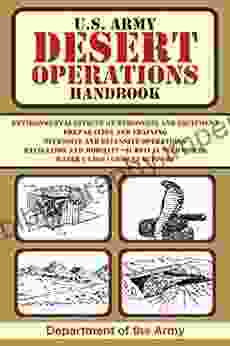Army Desert Operations Handbook: The Ultimate Guide to Surviving and Operating in Desert Environments

The desert is a harsh and unforgiving environment. Extreme temperatures, lack of water, and shifting sands can make it difficult to survive, let alone operate effectively. But with the right knowledge and skills, it is possible to not only survive in the desert but to thrive in it.
The Army Desert Operations Handbook is the definitive guide to surviving and operating in desert environments. This comprehensive manual covers everything from desert terrain and weather conditions to desert survival techniques and tactics.
4.9 out of 5
| Language | : | English |
| File size | : | 6751 KB |
| Text-to-Speech | : | Enabled |
| Screen Reader | : | Supported |
| Enhanced typesetting | : | Enabled |
| Word Wise | : | Enabled |
| Print length | : | 311 pages |
Desert Terrain
The desert is a vast and varied landscape, with a wide range of terrain features. From sand dunes to rocky plateaus, from dry riverbeds to salt flats, the desert offers a unique set of challenges for military operations.
The Army Desert Operations Handbook provides a detailed overview of desert terrain, including:
- Sand dunes: Sand dunes are one of the most common features of the desert. They can be small and isolated, or they can form massive dune fields that stretch for miles. Sand dunes can be difficult to traverse, and they can also be a hazard for vehicles.
- Rocky plateaus: Rocky plateaus are another common feature of the desert. These plateaus are often formed by ancient lava flows, and they can be very rugged and difficult to access. Rocky plateaus can provide good defensive positions, but they can also be difficult to defend against attack.
- Dry riverbeds: Dry riverbeds are often found in the desert. These riverbeds can be used as routes of travel, but they can also be a source of water during the rainy season.
- Salt flats: Salt flats are large, flat areas of land that are covered in salt. Salt flats can be very dangerous, as they can cause vehicles to sink. Salt flats can also be very hot, and they can reflect sunlight, which can lead to sunburn.
Desert Weather
The desert is also known for its extreme weather conditions. Temperatures can reach well over 100 degrees Fahrenheit during the day, and they can drop below freezing at night. The desert also experiences high winds and dust storms, which can make it difficult to see and breathe.
The Army Desert Operations Handbook provides a detailed overview of desert weather, including:
- Temperature: The desert is a hot environment, with temperatures often reaching well over 100 degrees Fahrenheit during the day. At night, temperatures can drop below freezing. Extreme temperatures can be dangerous, and it is important to take precautions to stay cool and hydrated.
- Wind: The desert is also known for its high winds. These winds can be strong enough to blow sand and dust, which can make it difficult to see and breathe. Wind can also cause dehydration, so it is important to drink plenty of water when you are exposed to high winds.
- Dust storms: Dust storms are a common occurrence in the desert. These storms can be very dangerous, as they can reduce visibility to zero. Dust storms can also cause respiratory problems, so it is important to wear a mask or respirator when you are exposed to dust.
Desert Survival Techniques
Surviving in the desert requires a combination of knowledge, skills, and equipment. The Army Desert Operations Handbook provides detailed instructions on desert survival techniques, including:
- Finding water: Water is essential for survival in the desert. The Army Desert Operations Handbook provides detailed instructions on how to find water in the desert, including how to collect dew, dig for water, and purify water.
- Building shelter: Shelter is important for protection from the sun, wind, and rain. The Army Desert Operations Handbook provides detailed instructions on how to build a shelter in the desert, using materials such as sand, rocks, and vegetation.
- Making fire: Fire can be used for cooking, warmth, and signaling. The Army Desert Operations Handbook provides detailed instructions on how to make fire in the desert, using materials such as wood, paper, and dry grass.
- Finding food: Food is not always easy to find in the desert. The Army Desert Operations Handbook provides detailed instructions on how to find food in the desert, including how to hunt, gather, and scavenge.
Desert Tactics
In addition to desert survival techniques, the Army Desert Operations Handbook also provides detailed instructions on desert tactics. These tactics include:
- Desert navigation: Desert navigation is essential for military operations. The Army Desert Operations Handbook provides detailed instructions on how to navigate in the desert, using a variety of methods such as celestial navigation, dead reckoning, and GPS.
- Desert camouflage: Desert camouflage is essential for concealment and deception. The Army Desert Operations Handbook provides detailed instructions on how to use desert camouflage, including how to choose the right colors and patterns, and how to apply camouflage to vehicles and equipment.
- Desert warfare: Desert warfare is a specialized form of warfare that requires a unique set of skills and tactics. The Army Desert Operations Handbook provides detailed instructions on desert warfare, including how to conduct desert patrols, how to attack and defend desert positions, and how to use desert terrain to your advantage.
The Army Desert Operations Handbook is the definitive guide to surviving and operating in desert environments. This comprehensive manual covers everything from desert terrain and weather conditions to desert survival techniques and tactics. Whether you are a soldier, a civilian, or an adventurer, the Army Desert Operations Handbook is an essential resource for anyone who wants to safely and successfully operate in the desert.
Free Download your copy of the Army Desert Operations Handbook today!
4.9 out of 5
| Language | : | English |
| File size | : | 6751 KB |
| Text-to-Speech | : | Enabled |
| Screen Reader | : | Supported |
| Enhanced typesetting | : | Enabled |
| Word Wise | : | Enabled |
| Print length | : | 311 pages |
Do you want to contribute by writing guest posts on this blog?
Please contact us and send us a resume of previous articles that you have written.
 Book
Book Novel
Novel Page
Page Chapter
Chapter Text
Text Story
Story Genre
Genre Reader
Reader Library
Library Paperback
Paperback E-book
E-book Magazine
Magazine Newspaper
Newspaper Paragraph
Paragraph Sentence
Sentence Bookmark
Bookmark Shelf
Shelf Glossary
Glossary Bibliography
Bibliography Foreword
Foreword Preface
Preface Synopsis
Synopsis Annotation
Annotation Footnote
Footnote Manuscript
Manuscript Scroll
Scroll Codex
Codex Tome
Tome Bestseller
Bestseller Classics
Classics Library card
Library card Narrative
Narrative Biography
Biography Autobiography
Autobiography Memoir
Memoir Reference
Reference Encyclopedia
Encyclopedia Mabagran
Mabagran Jenn Bennett
Jenn Bennett G E M Anscombe
G E M Anscombe G E Manwaring
G E Manwaring Fyodor Dostoevsky
Fyodor Dostoevsky Florin Diacu
Florin Diacu Peter L Rudnytsky
Peter L Rudnytsky Stephen Jones
Stephen Jones G F White
G F White M L Stratton
M L Stratton Mark Cotta Vaz
Mark Cotta Vaz Larry D Perry Iii
Larry D Perry Iii Fabienne Vailes
Fabienne Vailes Gary Brizendine
Gary Brizendine Frank B Cross
Frank B Cross Jean Pierre Verdy
Jean Pierre Verdy Garth Harvey
Garth Harvey Tony Russell
Tony Russell Valerie Menard
Valerie Menard Jill Childs
Jill Childs
Light bulbAdvertise smarter! Our strategic ad space ensures maximum exposure. Reserve your spot today!

 Hayden MitchellAn Introduction to Zoo Biology and Management: Unveiling the Secrets of the...
Hayden MitchellAn Introduction to Zoo Biology and Management: Unveiling the Secrets of the... Robert ReedFollow ·11.1k
Robert ReedFollow ·11.1k Chris ColemanFollow ·15.8k
Chris ColemanFollow ·15.8k John GreenFollow ·8k
John GreenFollow ·8k Ryūnosuke AkutagawaFollow ·11.7k
Ryūnosuke AkutagawaFollow ·11.7k Tony CarterFollow ·6.3k
Tony CarterFollow ·6.3k Donald WardFollow ·12k
Donald WardFollow ·12k Grant HayesFollow ·19.9k
Grant HayesFollow ·19.9k Foster HayesFollow ·16.9k
Foster HayesFollow ·16.9k

 Alexander Blair
Alexander BlairBecoming Sports Agent Masters At Work: The Ultimate Guide
What is a Sports...

 Xavier Bell
Xavier BellUnveiling the Enchanting World of Upper Bohemia: A Review...
A Captivating...

 Chris Coleman
Chris ColemanUnveiling the Secrets: Extreme Rapid Weight Loss Hypnosis...
In the relentless pursuit of a slimmer,...
4.9 out of 5
| Language | : | English |
| File size | : | 6751 KB |
| Text-to-Speech | : | Enabled |
| Screen Reader | : | Supported |
| Enhanced typesetting | : | Enabled |
| Word Wise | : | Enabled |
| Print length | : | 311 pages |
















